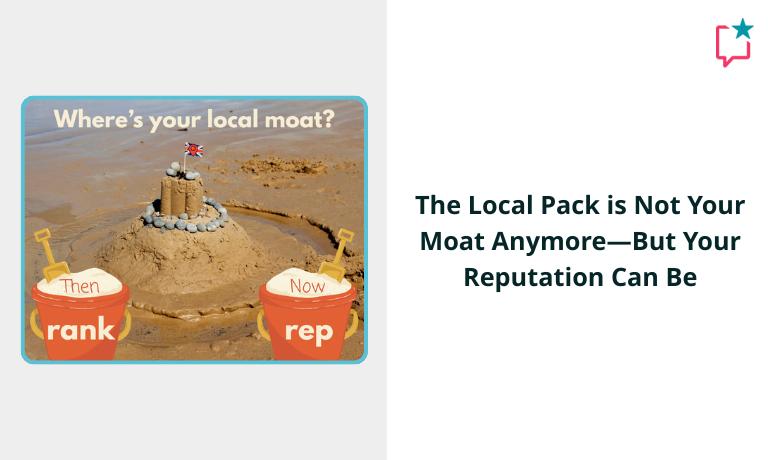
What should your local business actually be doing now that AI has come to town?
For the past 20 years, the majority of the digital marketing activities you’ve engaged in have gone into the big bucket of pursuing rank. With a high level of visibility in Google’s local packs for transactional intent queries, plus a content strategy that captured organic clicks for informational intent queries, you had built a strong moat around your castle. But now:
- Local packs are still appearing for about 39% of local business-related queries
- But AI Overviews are now appearing for 68% of local business-related queries
(Source: The Prevalence of AI Overviews in Local Search)
Today, we’re going to build a better moat for your brand via a combination of the ranking signals you know + the incoming tide of representation. You’ll learn how to respond to the new challenges and opportunities represented by the advent of AI to be sure you’re continuing to market your local business well going forward.
Let’s look at some local pack and AIO data
Just to be sure we’re on the same page, when we’re talking about local pack rankings, we mean this kind of display that comes up in Google when you do a search like “saltwater taffy shop Monterey”:
When we talk about AI Overviews (AIOs), we mean this newer feature that Google returns for queries like “how much does saltwater taffy cost in Monterey?”
Understandably, you may be feeling some concern reading studies like this one from Ahrefs, which finds that clickthrough rate drops by an average of about 35% when an AI Overview is shown in Google’s results. Instead of making it to your digital assets (like your website), a significant portion of your potential customers are simply encountering an AI Overview and not clicking at all.
But let’s take a more nuanced look at the local business scenario, based on a study I recently conducted with Whitespark. We found that:
- Local packs are still appearing for an average of 93% of local-intent queries. This would be your standard kind of local search like “salt water taffy shops near me”, “swimming trunks santa cruz”, or “seafood restaurant cannery row”.
- AI Overviews are now appearing for an average of 92% of informational-intent queries. Examples of informational-intent queries would be “how much does saltwater taffy cost?”, “can dogs swim in the ocean?”, or “what should I pack for a beach picnic?”
- AI Overviews are now appearing for an average of 97% of hybrid-intent queries. These queries tie informational + local search intents together. Examples would be “how much does saltwater taffy cost in Monterey?”, “is my dog allowed on Asilomar Beach?”, or “which delis sell picnic foods in Santa Cruz?”
By now, you may be wanting to get up from your computer and go to the beach, but the reason that we’re looking at this data is that, going forward, you’re going to need to pack two different concepts into your own picnic basket: rankings + representation.
What is the difference between local business rankings and representation?
Carousel Candies in the coastal town of Monterey, California has aced earning local business rankings. At least for my search, they are coming up in the top spot in Google’s local packs when I search for “salt water taffy shops Monterey”. We can see from the above screenshot how the reviews they’ve earned on their Google Business Profile are winning them a local justification, reading, “this place has the best salt water taffy selection.” So, to a degree, this candy store is already earning a kind of representation via their reviews.
But now, let’s look at whether they are earning representation in a relevant Google AI Overview.
Round of applause – this local business has definitely earned AIO representation. And we can explore this AIO for clues to how they’ve done it. When we dig in, we see that:
- Their own website is being cited.
- A 10-best list on Yelp is being cited.
- If we click through on the AIO to Google’s AI Mode, we see that the candy shop has earned a prominent mention on the Facebook page of a popular local tourism entity by celebrating their anniversary with a special offer and charitable giving:
- Other nearby candy stores are being cited by lifestyle publications about visiting the region, and I note this, because it shows that the AIO is scrambling to find relevant information even though I’ve specified that I want answers about the town of Monterey, rather than the neighboring town of Carmel-by-the-Sea:
- Google is pulling in a modified version of its Google Business Profile information:
Now, let’s prompt AI Mode to tell us what reviewers are saying about Carousel Candies.
Sources being cited to respond to this query include Yelp and TripAdvisor (no surprise), but wow, look at this! When asked about what reviewers are saying, AI Mode is citing “a Google user”:
And these citations are linking directly to the review profiles of people who write Google reviews, like this level 7 Local Guide who reviewed the candy store we’re studying:
So what have we learned? That your local pack rankings still matter in the AI Overview/AI Mode scenario, but you need broader representation than this made up of reviews, your own website content, and unstructured citations (mentions of your business on third-party sources like blogs, news sites, lifestyle magazines, social media, etc.) We’ve learned that:
- Google is bent on showing AIOs, particularly for informational and hybrid queries.
- Your potential customers are going to be digging around in the sands of AI Mode for all kinds of information, and Google will pull in irrelevant content if they can’t find enough unstructured citations that actually relate to your business (remember the Carmel-by-the-Sea example we just looked at).
- Reviews play a big part in being represented when AI Overviews are shown or when people step into AI Mode.
You Actionable Packing List for AIO/AI Mode Representation
Being a California girl, I grew up knowing what to pack for a good day at the beach, but AI has leveled the local business playing field: this is new to all of us! What you’ve earned through trial and error about local pack rankings still applies and is still where you need to be focusing when it comes to those traditional local-intent queries. But, for informational and hybrid-intent queries, or for AI Mode in general, all these belong in your bucket:
☑ Relevant reviews
Explore AI Overviews and AI Mode for your most important queries and make a list of the sources being pulled most frequently for review content. This is where you need to be getting reviews. If you know you’ve been letting your review acquisition work slide, the emergence of AI is a big signal to reboot your reputation program. Need to increase review volume and velocity to catch up to competitors who are getting ahead of you in the new AI environments?
- Remember to actively ask for reviews. According to GatherUp’s major consumer review survey, the #1 reason people don’t write more reviews is because they forget. A review request is the best possible reminder!
- Collect both email and text numbers. Request reviews via both methodologies to increase response rate.
- Respond to your existing reviews to demonstrate to other customers that you care. It’s a good incentive for them to devote their own free time to writing a review for your business.
- Get organized! Managing reviews across multiple platforms (and multiple locations of your business) can be messy work without a single dedicated dashboard. GatherUp can help!
Pro Tip: Note that this article is solely focused on Google’s versions of AI. There are multiple other AI environments your customers may be exploring right now, like ChatGPT or Perplexity. Preferred review sources may differ across diverse platforms. For example, I’ve noticed Google’s AIO pulling in lots of content from TripAdvisor, but I haven’t seen any TripAdvisor reviews being cited by ChatGPT. Your task is to find out which platforms preference which review sources for the queries that matter to you.
☑ Unstructured Citations
We saw AIO scrounging around for good mentions of the candy shop we’ve been looking at, and even pulling up a lifestyle magazine from another state mentioning a business in a town some miles away from the one we asked about. Now is the time to ensure AI can scrape as much third-party content as possible about your business. Excellent tactics for earning these mentions include:
- Offering newsworthy stories to local online news sites, hyperlocal bloggers, tourism publications, lifestyle publications, local podcasts, and local vloggers
- Being a guest who is interviewed on these types of publications
- Hosting or sponsoring local events, teams, and causes
- Cross-promoting with friendly fellow business owners in your town
- Advertising in the online versions of local publications from houses of worship, schools, and business organizations
- Offering memorable consumer experiences in the real world that lead to customers promoting your business via their own social media postings
☑ Your Website Content
This tactic isn’t new. I know I’ve been promoting it for decades. Use your website to answer the kinds of questions people ask you in the real world and that you’ve seen showing up in question-oriented keyword research tools like Answer the Public and AlsoAsked.com.
I believe we’ve reached the 10th anniversary of the debut of Google’s “People also ask” SERP feature, and I’m sure you’ve heard SEOs recommending that you check out this display to help you brainstorm what kinds of questions you should be answering on your website.
Now we’ve got a new kid on the block. I’ve noticed a Google AI Mode feature that is similar to “People also ask”, but which is returning different prompts:
If you were marketing a candy shop, this feature could be useful in sparking some content that could help you get represented in Google’s AI.
Pro Tip: The important thing to remember here is that AI is not particularly intelligent. If it finds the “token” of your business name frequently cited in close proximity to other search phrase “tokens” like “the most saltwater taffy flavors” in your own content or in third-party content, this will influence your AI representation for the terms you are pursuing.
Plugging your local moat leak
It’s no surprise if you’re feeling a little anxious seeing some portion of the clicks you’ve previously enjoyed leaking away into Google’s AI drains. It’s hard to respect an interface that is infamous for its intrusiveness and hallucinations, and the jury is still out as to how much real human beings like your customers will actually come to engage with AI features over time.
It can help to remember that, at least for now, all the time, money, and effort you’ve invested in pursuing local pack rankings is likely still driving the majority of your online-to-offline conversions. AI is not a sea change in the local business environment. Right now, it’s just making some waves. But experienced coast dwellers know that you never turn your back on the ocean. You watch it for signs and alterations. In 2025, all local business owners are standing on the same shore trying to measure and adjust this new tide.
Shoring up your moat comes down to placing a new level of emphasis on what third-parties, including reviewers and local publishers, have to say online about your brand. A combination of exceptional customer service, memorable consumer experiences, active review acquisition, and PR outreach to local publishers and socializers should stand you in good stead on this beachhead.
Would partnering with pros give you more confidence? At GatherUp, we’re old salts at reputation management and we’re strategizing to turn that into a winning plan for AI representation.
Reach out to us.
